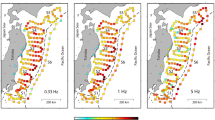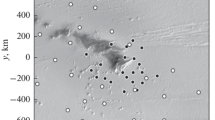Abstract
The peculiarities of the microseisms spectra shape when recording on the ocean floor in the frequency band of 0.003–20 Hz are examined. The origin of the stable minima in the microseisms spectrum (“transparency windows”) at frequencies of about 0.02–0.1 Hz and 5–15 Hz is analyzed. In these frequency bands, weak earthquake signals are recorded by bottom instruments. The origin of the low-frequency “transparency windows” can be explained by the conditions of the microseisms propagation in the oceanic waveguide (between the bottom and the water’s surface) in the abyssal plain zones. The results of the full-waveform numerical simulation of the seismoacoustic waves propagation in the oceanic environment and on the ocean-continent border are presented, and the experimental data as well. The peculiarities of the microseisms spectra in the band of high-frequency “transparency windows” can be caused by the constructive resonance in the water-saturated layer of bottom sediments. The theoretical foundation and experimental results are given.
Similar content being viewed by others
References
K. Aki and P. G. Richards, Quantitative Seismology, Theory and Methods, 2 vols. (Freeman, San Francisco, 1980).
Acoustic of the Ocean Ed. by L. M. Brekhovskikh (Nedra, Moscow, 1974) [in Russian].
L. M. Brekhovskikh and O. A. Godin, Acoustic of Stratified Mediums (Nedra, Moscow, 1989 [in Russian].
L. M. Brekhovskikh and V. V. Goncharov, “Sound Generation by Surface Waves Including Bottom Reflections,” Izv. Acad. Sci. USSR. Atmos. Okean. Phys. 5(6), 608–615 (1969).
L. P. Vinnik, “A Structure of 4–6-Second Microseisms,” Dokl. Akad. Nauk SSSR 162(5), 1041–1044 (1965).
V. I. Volovov, Sound Reflection from the Ocean Bottom (Nedra, Moscow, 1997) [in Russian].
B. Gutenberg, Physics of the Earth’s Interior (IL, Moscow, 1963) [in Russian].
I. N. Davidan, “Frequency Spectrum of the Wind Oscillation,” in The Study of the Northern Atlantic Basin, Ed. by B. A. Filippov (Gidrometeoizdat, Leningrad, 1969), pp. 185–210.
T. A. Dozorov and S. L. Solov’ev, “Registration of Bottom Seismic Noises in Diapason 0.01–10 Hz,” Izv. Acad. Sci. USSR. Phys. Solid Earth, No. 8, 10–19 (1990).
I. N. Ermakov, “Frequency Spectra of the Noise Field in Planar Waveguide,” Akust. Zh. 32(2), 264–267 (1986).
M. A. Zhdanov, D. G. Levchenko, and S. L. Solov’ev, “Fluctuation of Bottom Seismic Noises in Diapason 0.01–10 Hz (Northern Aegean Trough),” Okeanologiya 33(2), 299–303 (1993).
A. V. Il’in and G. V. Bogorov, “The Method of Quantitative Assessment of the Bottom Relief,” Okeanologiya 11(2), 326–333 (1971).
M. A. Isakovich, General Acoustic (Nedra, Moscow, 1973) [in Russian].
I. F. Kadykov, Submerged Low Frequency Acoustic Noise of the Ocean (Editorial URSS, Moscow, 1999) [in Russian].
Yu. M. Krylov, Wind, Waves, and Marine Ports (Gidrometeoizdat, Leningrad, 1986) [in Russian].
B. F. Kur’yanov, “Possibility of Passive Acoustic Tomography in Diffusive Noise Field,” in Acoustic in the Ocean (GEOS, Moscow, 2006), pp. 179–185.
V. D. Levchenko, “Asynchronous Algorithms as the Mean to Achieve the High Efficiency of Calculations,” Inform. Tekhnol. Vychislit. Sist., No. 1, 1–25 (2006).
D. G. Levchenko, Registration of the Broadband Seismic Signals and Possible Forerunners of Heavy Earthquakes on the Marine Bottom (Nauchnyi Mir, Moscow, 2005) [in Russian].
D. G. Levchenko, “Propagation of Storm Microseism at the Ocean-Continent Boundary,” Oceanology 49(2), 257–264 (2009).
D. G. Levchenko, V. D. Levchenko, and A. V. Zakirov, “Dynamic Full-Wave Modeling of Storm Microseism Propagation in an Oceanic Environment,” Oceanology 51(4), 677–687 (2011).
A. P. Lisitsyn, Sedimentation in the Oceans (Nedra, Moscow, 1974) [in Russian].
F. I. Monakhov, Low-Frequency Seismic Noise of the Earth (Nedra, Moscow, 1977) [in Russian].
Yu. P. Neprochnov, V. V. Sedov, and A. A. Ostrovskii, “Experimental Studies of Bottom Seismic Noise in the Ocean,” Okeanologiya 23(2), 276–283 (1983).
A. A. Ostrovskii, Bottom Seismic Experiments (Nedra, Moscow, 1998) [in Russian].
A. B. Rabinovich, Long Gravitational Waves in the Ocean: Capture, Resonance, and Irradiation (Gidrometeoizdat, St. Petersburg, 1993) [in Russian].
E. F. Savarenskii, Seismic Waves (Nedra, Moscow, 1972) [in Russian].
S. L. Solov’ev, Seismic Bottom Observations in USSR and Abroad (Nedra, Moscow, 1986) [in Russian].
V. N. Tabulevich, Storm Microseismic Oscillations and the Complex of Simultaneous Events in Atmosphere (Nauka, Novosibirsk, 1986) [in Russian].
I. Tolstoi and K. S. Klei, Acoustics of the Ocean (Mir, Moscow, 1969) [in Russian].
V. R. Fuks, Introduction into the Theory of Wave Transfers in Ocean (ILU, Leningrad, 1982) [in Russian].
Physics of Sound in Marine Sediments Ed. by L. Hampton (Plennum, New York, 1974).
R. G. Adair, J. A. Orcutt, and T. H. Jordan, “Low-Frequency Noise Observations in the Deep Ocean,” J. Acoust. Soc. Am. 80(2), 633–645 (1986).
D. S. Agnew, “Vertical Seismic Noise at Very Low Frequencies,” J. Geophys. Res. 83(11), 5420–5424 (1978).
I. N. Brune and J. Oliver, “The Seismic Noise of the Earth’s Surface,” Bull. Seism. Soc. Am., 49(4), 349–353 (1959).
N. R. Chapman and D. M. Chapman, “A Coherent Ray Model of Plane-Wave Reflection from a Thin Sediment Layer,” J. Acoust. Soc. Am. 94(5), 2731–2738 (1993).
B. F. Cron and C. N. Sherman, “Spatial-Correlation Function for Various Noise Models,” J. Acoust. Soc. Am. 34(11), 1132–1136 (1962).
C. Eskart, “The Theory of Noise in Continuous Media,” J. Acoust. Soc. Am. 25(2), 195–199 (1953).
O. A. Godin and D. M. F. Chapman, “Shear-Speed Gradients and Ocean Seismoacoustic Noise Resonances,” J. Acoust. Soc. Am. 106(5), 2367–2382 (1999).
K. A. Hasselmann, “A Statistical Analysis of the Generation of Microseisms,” Rev. Geophys. Res. 1(2), 177–210 (1963).
H. Jeffreys, “the Reflection and Reposition of Elastic Waves,” Geophys. J. R. Astron. Soc. 1,Suppl. P. 321–334 (1926).
M. S. Longuet-Higgins, “Can Sea Waves Cause Microseisms?” in Proc. Symp. on Microseisms (Harriman, New York, 1952), pp. 74–86.
T. Ouchi, “Spectral Structure of High Frequency P and S Phases Observed by OBSs in the Mariana Basin,” J. Phys. Earth, No. 29, 305–326 (1981).
C. L. Pekeris, “Theory of Propagation of Explosive Sound in Shallow Water,” Geol. Soc. Am. Mem. 27, 1–117 (1948).
J. Peterson, “Observation and Modeling of Seismic Background Noise,” in U. S. Geol. Surv. Tech. Rept. 93-322 (Albuquerque, New Mexico, 1993).
F. Press and M. Ewing, “A Theory of Microseisms with Geologic Applications,” Trans. Am. Geophys. Union 29(3), 163–174 (1948).
H. Schmidt and W. A. Kuperman, “Estimation of Surface Noise Source Level from Low Frequency Seismoacoustic Ambient Noise Measurement,” J. Acoust. Soc. Am. 84(6), 2153–2162 (1988).
M. Shinohara, et al., “Deep Sea Borehole Seismological Observatories in the Western Pacific: Temporal Variation of Seismic Noise Level and Event Detection,” Ann. Geophys. 49(2/3), 625–641 (2006).
G. H. Sutton and N. Barstow, “Ocean Bottom Ultralow-Frequency (ULF) Seismoacoustic Ambient Noise: 0.002 to 0.4 Hz,” J. Acoust. Soc. Am. 87(5), 2005–2012 (1990).
G. Sutton, C. McGreery, F. Duennebier, and D. Walker, “Spectral Analyses of High-Frequency P n, S n Phases Recorded on Ocean Bottom Seismographs,” Geophys. Res. Lett., No. 5, 745–747 (1978).
D. Walker, G. Sutton, and C. McGreery, “Spectral Characteristics of High-Frequency Pn, Sn Phases in the Western Pacific,” J. Geophys. Res. 88, 4289–4298 (1983).
S. C. Webb, “The Equilibrium Oceanic Microseism Spectrum,” J. Acoust. Soc. Am. 92(4), Part 1, 2141–2157 (1992).
S. C. Webb and C. S. Cox, “Observations and Modeling of Seafloor Microseisms,” J. Geophys. Res. 91(B7), 7343–7358 (1986).
Author information
Authors and Affiliations
Corresponding author
Additional information
Original Russian Text © D.G. Levchenko, V.D. Levchenko, 2013, published in Okeanologiya, 2013, Vol. 53, No. 3, pp. 332–346.
Rights and permissions
About this article
Cite this article
Levchenko, D.G., Levchenko, V.D. Nature of “transparency windows” in the broadband spectrum of seafloor microseisms. Oceanology 53, 294–307 (2013). https://doi.org/10.1134/S0001437013020100
Received:
Accepted:
Published:
Issue Date:
DOI: https://doi.org/10.1134/S0001437013020100




